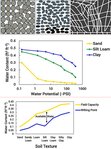South Dakota Extension forage field specialist
With widespread flooding and rainfall events across the state, it seems fitting to discuss how soils retain and utilize water this week. I’ve taken paraphrased excerpts from an article my …
This item is available in full to subscribers.
To continue reading, you will need to either log in to your subscriber account, below, or purchase a new subscription.
Please log in to continue |


With widespread flooding and rainfall events across the state, it seems fitting to discuss how soils retain and utilize water this week. I’ve taken paraphrased excerpts from an article my co-worker, Hans Klopp (SDSU soil health field specialist) and Anthony Bly (SDSU soils field specialist) put together for this week's article. For their original article, go here.
Water infiltrates into soil through pores, or voids between individual soil particles and clumps of particles. Soil is made up of sand, silt, and clay sized particles and organic matter. Sand particles are spherically shaped and usually have large voids between individual particles (Figure 1). Silt-sized particles are smaller than sand particles with smaller pore spaces between particles and a more-irregular arrangement of pores. Silt particles are usually oval or irregularly shaped (Figure 2). Clay particles are the smallest particle size. Clay particles are usually flat-shaped, like a playing card, but much smaller. Clay particles have a very high surface area/volume ratio compared to sand and silt particles (Figure 3). In addition to particle size, organic matter content also affects how much water is retained by the soil. Organic matter is important in the formation of structure and has high surface area; soils with high organic matter content generally have higher water retention.
Data from measuring soil water content at different pressures (water potentials) is made into the “soil water retention curve”. An example of a soil water retention curve for a sand, silt loam, and clay textured soil is shown in Figure 4. A strong negative force is required for water to be released from a clay soil texture; however, water is easily released from sandy soils. This is why the clay textured soils retain more water than sandy soils. When soil is compacted (higher bulk density, but lower porosity) it will retain less water at water pressures closer to 0, but it will retain more water when the potential becomes more negative. The many fine pores in clay textured soils require a very negative pressure for water to be extracted from them.
Field capacity is the amount of water that the soil retains when water is no longer drained from the soil by gravity. Think of a sponge that was saturated and then has been allowed to drain by gravity. Field capacity generally increases as soil organic matter and clay content increases.
The permanent wilting point is the soil water content at which plants can no longer extract water from the soil. Plants will die if the soil remains at this water content or below for an extended period of time. Water is very strongly held between interaggregate pores and absorbed to clays when the soil is at wilting point. Soils with higher clay and organic matter content generally have a higher permanent wilting point.
Plant available water is the amount of soil water that is available to plants. Plant available water is determined by subtracting wilting point from field capacity. An example of field capacity and wilting point for different soil textures is shown in Figure 5. Plant available water is indicated by the arrow. Intermediate soil textures, like a silt loam, generally have the highest plant available water. This is due to this soil texture containing a variety of soil pore sizes.
Water holding capacity is another soil property commonly discussed. This is measured by saturating a soil with water, then allowing it to freely drain until water stops dripping. This value is similar to what field capacity is; however, (unlike field capacity) the water potential that this occurs at may vary depending on soil texture. The water potential would be closer to 0 in sandy soils and water potential is more negative in finer textured soils.
Water retention is an important soil property and is related to soil texture, organic matter content, and density. Sandy soils have low water retention, whereas clayey and high-organic-matter-content soils have higher water retention. Porosity/saturated water content, field capacity, wilting point, and plant available water are commonly used measurements related to soil water retention.
Water is an ever-present issue in dryland farming, and widespread flooding events made the last couple weeks a challenge for many. In addition to flooding issues, our local area has experienced more than one tragic accident recently, causing many to pause and think about what really matters. I encourage you to live each day to the fullest and find a nugget of “good” in everything. I hope we can all find a reason to be thankful for today as we never know what tomorrow may bring.